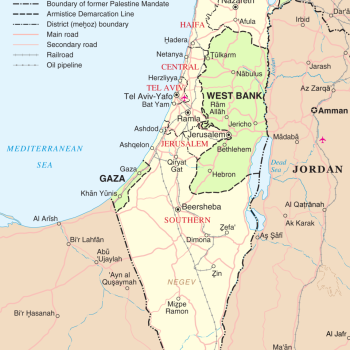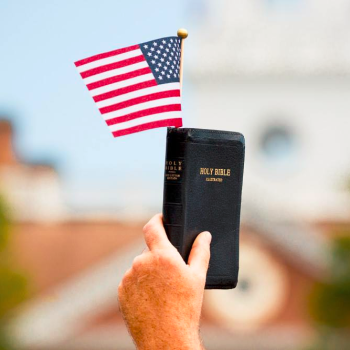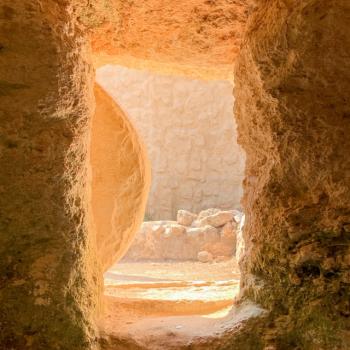
Friends, today I continue my series on miracles. This third article focuses on the place of the miracles in the teaching of Jesus and, in particular, their relationship to his focus on the Kingdom of God.
+++
Historically, the miracles of Jesus have been a deal-breaker. Thomas Jefferson famously created his own Gospel, cutting all of them out of his version. A German theologian by the name of Rudolf Bultmann “demythologized” the Gospels. In this country Harry Emerson Fosdick, who was the founding pastor of Riverside Church in Manhattan, offered alternative explanations for the miracles and argued that whatever else one thought about them, you should never base any theology on them.
But the Gospels don’t flinch at recounting them. And the other claims that they make about Jesus make the miracles look trivial by comparison. In his book, Mere Christianity, C.S. Lewis puts the choice in stark terms:
A man who was merely a man and said the sort of things Jesus said would not be a great moral teacher. He would either be a lunatic — on the level with the man who says he is a poached egg — or else he would be the Devil of Hell. You must make your choice. Either this man was, and is, the Son of God, or else a madman or something worse. You can shut him up for a fool, you can spit at him and kill him as a demon or you can fall at his feet and call him Lord and God, but let us not come with any patronizing nonsense about his being a great human teacher. He has not left that open to us. He did not intend to.
I think that Lewis is right and for that reason I want to explore the significance of miracles in the Gospels, rather than side-step them.
The first thing to observe is that the life and ministry of Jesus, is itself a sign, a wonder, and an act of power. Two of them, actually, the Incarnation and the Resurrection.
Jesus is fully man, fully God. He enters into the burning house that is our life, living the perfect balance that we were intended to enjoy.
Taking that balance to the cross, he breaks the power of sin and death, paving the way for our own Resurrection. And the path that he opens up for us, as a result, is one of life in the presence of God.
A second thing to note is – as I have said before – these miracles are not a violation of natural law. They are God’s work in God’s creation. And this is just as true of the Incarnation and Resurrection as it is of any other sign, manifestation of power or occasion of wonder in the life of Jesus.
We assume that because the Incarnation or Resurrection aren’t daily experiences that they are examples of God acting on the world from outside. But the Incarnation and Resurrection are not alien to creation in an important and profound sense.
They are aimed at restoring creation to its God-given state, and – as such – they aren’t an interference with nature. They return nature to its intended state, defeating the obstacles to God’s will for creation, the power of both sin and death.
Now, knowing that these are the assumptions at work behind the ministry of Jesus, it is clear that the signs, wonders, and acts of power in his ministry are perfectly congruent with the biblical accounts of his birth and Resurrection. He is not an interloper. He is not a bolt from the blue.
He is the mind of God – the logic of creation – brought brought to bear on a world bedeviled by sin and death. And his life and ministry inaugurate the process of reclaiming, freeing, and restoring creation to what it was meant to be.
But this also means that miracles are the beginning of a spiritual battle that embraces the whole of creation. And Jesus will be opposed by everything that sin and death can muster.
This is why the birth of Jesus is opposed by Herod, who represents the refusal of earthly princes to acknowledge that God is God. This is why Mary describes the birth of her Son as the occasion for liberation in the Magnificat. This is why the ministry of Jesus begins with the temptation in the wilderness. And it is why, closer to the end of his life, Jesus describes his own ministry as one of exorcism and healing.
The contemporary world sees miracles as proofs of God’s existence in the world. Jesus sees the world as God’s creation where sin and death are the interlopers; and with his coming, their defeat is in motion.
This, in turn, helps to explain why the phrase, “the Kingdom of God” is central to Jesus’ message. As he teaches and works miracles, he is trying to describe what the world will look like as God reasserts his reign. And the miracles he performs are not an end in themselves, but a window into what God’s reign is all about.
Now, we could spend three months or more, talking about the miracles in the Gospels. Depending upon the way they are counted, there are at least 37 miracles in the Gospel tradition. And, broadly speaking, there are four kinds of signs, acts of power, and occasions for wonder: exorcisms which involve casting out demons and unclean spirits); healing miracles (which include the cure of physical impairments and illnesses); nature miracles (such as the calming of the storm on the Sea of Galilee and the feeding of the multitudes); and restoration miracles (which involves raising the dead).
Now, if the Gospels are read as simply the activity of a miracle worker – even a compassionate one – the miracle stories can seem pretty random and unrelated. But if one realizes that the life and ministry of Jesus are about the reclamation of God’s creation and liberation from the power of sin and death, they look more like a four-pronged assault in a spiritual and physical battle to recapture creation.
I say spiritual and physical, because the issue in the ministry of Jesus is not just about “principalities and powers” or “hearts and minds”. It is also about the claim of God to be the creator and author of life.
Let me take each prong of that attack in order:
Prong one in God’s attack are exorcisms and the casting out of demons.
These have nothing to do with the depictions that you usually see in movies. And it has nothing to do with little men in red tights, a pair of horns, and a tail. These miracles are about God in Christ confronting the power of evil.
If we fail to recognize this, the pictures of Jesus as a benign spirit person or a proto-Marxist will continue to be attractive. But you are forced to ignore this element of Jesus’ ministry, call them metaphors for something else, or cut them out of the Gospels completely in order to make those pictures work.
One of the reasons that our tradition includes baptismal vows in which we are called upon to renounce evil; a Eucharistic liturgy that requires public; and the absolution of sins is because you cannot really argue that you understand the teaching of Jesus and ignore those stories. (Those vows, by the way, come straight out of Paul’s letter to the Ephesians and the earliest practice of the church.)
Much the same can be said of the healing miracles, which is the second prong of God’s battleplan. We are tempted to think of healings in narrow and personal categories. And when we do, God becomes a cosmic bellhop, who is all about managing our problems.
But in this second prong of the battle that God launches in the Incarnation, Jesus is doing battle with the physical consequences of sin and death. This is why, in fact, that the people he heals are often first forgiven their sins, if there are sins involved.
But – more broadly – it is impossible to argue that God is the author of life, if illness and physical limitations mar that claim. The healing miracles, then, point to the restoration and wholeness that marks life in the Kingdom and the conviction that this process of restoration has begun.
If you’ve ever wondered why bodily Resurrection is so important in the Christian tradition, this is why. Contrary to one strange and heretical strain of teaching in some churches, God is not going to preserve your soul and abandon your body. Both are the good gift of God at creation and Jesus is not going to leave either one behind.
Resurrection is the ultimate proclamation that everything about being human has been restored and made whole. As the Resurrected Christ declares in the Book of Revelation, “I come to make all things new.”
The third prong of the battle are the nature miracles. Here, again, the breadth of the reclamation in which God is involved goes well beyond us and embraces nothing short of heaven and earth.
If you’ve ever wondered why nature seems both breathtakingly beautiful and viciously destructive — or you’ve marveled at our ability to nurture creation and out callousness in caring for it — here is the explanation. As Paul points out, creation writhes in birth pangs for the delivery of humankind, so that it can be delivered as well. And Jesus, the mind of God, the creator of all that is, makes it clear in these miracles that he remains the Lord of creation.
The fourth prong of the battle, the miracles of restoration, underline God’s power to make good on all of those promises. As I’ve said before, we misunderstand the miracles if we over personalize them. This isn’t to say that they shouldn’t matter to us or that we shouldn’t be grateful for them. It doesn’t mean that we shouldn’t pray for them.
But our well-being is grounded in something much larger and that much larger issue is God’s power to conquer death. And the only weapon at hand in that battle is Resurrection.
This is why, as Christians, when we have a funeral we celebrate the hope of the Resurrection. If God’s work in Christ doesn’t transcend our lives and generations of death and destruction – if the power of the Resurrection is just a metaphor for new life – Paul was right, we are without hope.
And when Jesus restores Lazarus to life and heals Jairus’ daughter, he is asserting his authority over that which seems to contradict the argument that God is God. And in his own Resurrection the power of death is completely broken.
Those, then, are the four prongs of God’s plan of attack: the war on evil, the spread of healing, the battle to restore creation, and the conquest of death. So, how should the Gospel message shape our understanding of the miracles?
One, we should recognize their purpose in illuminating the work of Jesus and the purposes of God’s Kingdom.
Two, we should do more than connect with them personally and privately. We should recognize the fact that in them, Jesus enacts a new reality.
Three, we should remember that we are in a spiritual battle. This need not make us grim or morbid. But it should remind us that we cannot be blithe about what is at stake or superficial about our faith. We are engaged in something serious with eternal consequences.
And, four, we should let God’s purposes for the Kingdom inform our purposes for the way in which we live. We, as members of Christ’s body, are meant to be instruments of spiritual freedom, healing, restoration, and Resurrection hope. And we should cultivate lives and language that will help us to do that work.
Let us pray:
Lord Jesus Christ, Son of the Father, the mind of God at the beginning of all that is, architect of life and light. Save us from letting your power become a personal possession or private preoccupation. Instead, let us draw hope and inspiration from your life and your work; and let our lives be the harbingers of your Kingdom. That you might be known and recognized throughout the world. Amen.














